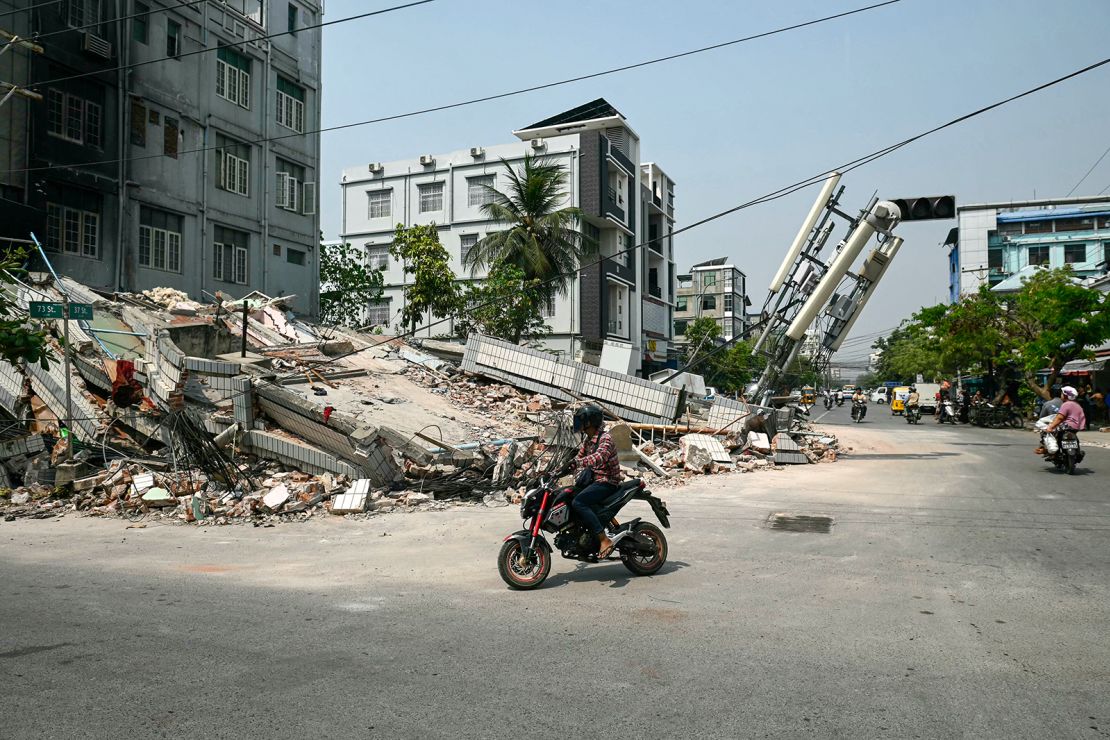CNN
—
Buildings in Myanmar are continuing to collapse five days after a powerful earthquake struck the country, creating perilous conditions for rescuers as they attempt to extricate survivors from the rubble.
More than 2,700 people were killed in the 7.7-magnitude quake, with thousands more injured, according to Myanmar’s military junta. Hundreds more remain missing, meaning the death toll is almost certain to rise.
The Myanmar Fire Services Department on Wednesday shared video of a heartwarming moment in the military capital Naypyidaw, where workers pulled a man from the rubble more than 100 hours after the quake, a miraculous rescue that offered a rare moment of hope.
The man appeared tired and disheveled as he was pulled out of an air pocket between broken slabs of concrete, to a round of applause.
A day earlier, a 62-year-old woman was similarly pulled from broken slabs of concrete in Naypyidaw.
Elsewhere, a team of Chinese rescuers on Monday pulled four people – including a five-year-old child and a pregnant woman – from the rubble.
Structurally vulnerable buildings in the country are still collapsing as tremors continue, according to human rights organizations, highlighting the dangers of the rescue mission.
Two hotels collapsed near the epicenter in Mandalay Monday night, after people went back to the structures days after the quake.
“With these additional tremors, fatalities are still occurring,” said Michael Dunford, Myanmar director at the United Nations World Food Programme.
“Many people are still sleeping out in the open on the streets or in the parks because they are too scared to go back into their homes. And of course, this is hampering our efforts to reach them and to provide the type of support that they need.”
Humanitarian organizations are continuing to stress the need for urgent aid, especially to more remote areas of the country.
Even before the quake, four years of civil war had left millions without adequate shelter and battered health and communication infrastructure.

In Sagaing town, near the epicenter of the quake, residents have described scenes of heartbreak and desperation as they wait for urgent medical supplies and food.
Rights group Amnesty International spoke to three residents, who said there was a rising need for body bags, torches, and mosquito-repellant coils. They also told the group that the military, which largely controls the town, was imposing “strict surveillance” for light vehicles traveling to Sagaing from Mandalay.
“Soldiers are inspecting deliveries, and checks can take longer if they come from other areas in Sagaing that have more connections to resistance groups,” Amnesty said.
The ruling junta seized power from Myanmar’s democratically elected government in 2021, sparking a brutal civil war between ethnic rebel groups and its military.
While the junta has reaffirmed its commitment to allowing assistance, rights groups have criticized Myanmar’s leaders for restricting access to some affected areas.
“The junta needs to break from its appalling past practice and ensure that humanitarian aid quickly reaches those whose lives are at risk in earthquake-affected areas,” said deputy Asia director at Human Rights Watch Bryony Lau.
Amnesty International on Tuesday urged Myanmar’s military to “refrain from deliberate air strikes and other forms of attack on civilian targets” in earthquake-affected areas.
Meanwhile, a major rebel alliance in Myanmar declared a temporary ceasefire to facilitate rescue efforts.
“We strongly desire that urgent humanitarian efforts, which are immediately needed for the earthquake-affected population, be carried out as swiftly and effectively as possible,” the Three Brotherhood Alliance, which involves the Ta’ang National Liberation Army, the Kokang’s Myanmar National Democratic Alliance Army and Arakan Army, said in a joint statement Tuesday.
International teams, including groups from China, Russia, and Pakistan, have been assisting with rescue efforts in Myanmar. Two Indian naval vessels carrying humanitarian aid, relief supplies and food arrived in Yangon Tuesday morning.
But humanitarian workers have warned that years of underfunding means more needs to be done.
“This is time, to be honest, for the world to step up and support the people of Myanmar,” UN Humanitarian Coordinator for Myanmar Marcoluigi Corsi said Tuesday.
“We keep saying that Myanmar does not rank very high among the different emergencies… The humanitarian response in Myanmar has been chronically underfunded for years. Four months into the year right now, less than 5 per cent of the required US$1.1 billion of the Humanitarian Response Plan has been received.”
Friday’s devastating quake was felt all the way in neighboring Thailand, where at least 22 people died in the capital Bangkok.
Of that number, 15 people were killed after an under-construction high-rise building collapsed, officials said.























